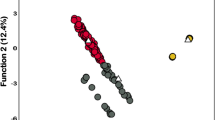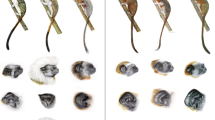Abstract
Hybridization of wildlife species, even in the absence of introgression, is of concern due to wasted reproductive effort and a reduction in productivity. In this study we detail an accidental mating between a female nyala (Tragelaphus angasii) and a male greater kudu (T. strepsiceros). The hybrid was phenotypically nyala and was identified as such based on mitochondrial DNA. Further genetic analysis based on nine microsatellite markers, chromosome number and chromosome morphology however, confirmed its status as an F1 hybrid. Results obtained from a reproductive potential assessment indicated that this animal does not have the potential to breed successfully and can be considered as sterile.




Similar content being viewed by others
References
Allendorf FW, Leary RF, Spruell P, Wenburg JK (2001) The problems with hybrids: setting conservation guidelines. Trends Ecol Evol 16:613–622
Barilani M, Bernard-Laurent A, Mucci N, Tabarroni C, Kark S, Garrido JAP et al (2007) Hybridization with introduced chukars (Alectoris chukar) threatens the gene pool integrity of native rock (A. graeca) and red-legged (A. rufa) partridge populations. Biol Conserv 137:57–69
Brooke RK, Lloyd PH, de Villiers AL (1986) Alien and translocated terrestrial vertebrates in South Africa. In: Macdonald IAW, Kruger FJ, Ferrar AA (eds) The ecology and management of biological invasions in Southern Africa. Oxford University Press, Cape Town, pp 229–238
Chandley AC, Jones R, Dott HM, Allen WR, Short RV (1974) Meiosis in interspecific equine hybrids: I. The mule (E. assinus × E. caballus) and hinny (E. caballus × E. asinus). Cytogenet Cell Genet 13:330–334
Crosier AE, Pukazhenthi BS, Henghali JN, Howard JG, Dickman AJ, Marker L et al (2006) Cryopreservation of spermatozoan from wild born Namibian cheetah (Acinonyx jubatus) and influence of glycerol on cryosurvival. Cryobiology 52:169–181
Eljarah A, Al-Zghoul MB, Jawasreh K, Ababneh M, Alsumadi M, Alhalah A et al (2012) Characterization of male reproductive anatomy of the endangered Arabian oryx (Oryx leucoryx). Theriogenology 78(1):159–164
Excoffier L, Smouse PE, Quattro JM (1992) Analysis of molecular variance inferred from metric distances among DNA haplotypes: application to human mitochondrial DNA restriction data. Genetics 131:479–1491
Excoffier L, Laval G, Schneider S (2005) Arlequin (version 3.0): an integrated software package for population genetics data analysis. Evol Bioinform Online 1:47
Gray AP (1971) Mammalian hybrids. Commonwealth Agricultural Bureau, Edinburgh
Grobler JP, Van der Bank FH (1995) Allozyme divergence among four representatives of the subfamily Alcelaphinae (family: Bovidae). Comp Biochem& Physiol 112:303–308
Grobler JP, Rushworth I, Brink JS, Bloomer P, Kotze A, Reilly B et al (2011) Management of hybridization in an endemic species: decision making in the face of imperfect information in the case of the black wildebeest—Connochaetes gnou. Eur J Wildl Res 57:997–1006
Hsieh H, Chiang H, Tsai L, Lai S, Huang N, Linacre A et al (2001) Cytochrome b gene for species identification of the conservation animals. Forensic Sci Int 122:7–18
Newell-Fugate A, Nothling J, Bertschinger H (2012) Seasonal changes in steroid hormone profiles, body weight, semen quality and the reproductive tract in captive wild dogs (Lycaon pictus) in South-Africa. Gen Comp Endocrinol 178:272–281
O’Brien SJ, Menninger JC, Nash WG (2006) Atlas of mammalian chromosomes. John Wiley & Sons, Hoboken
Peakall R, Smouse PE (2006) GenAlEx 6: genetic analysis in Excel. Population genetic software for teaching and research. Mol Ecol Notes 6:288–295
Posada D (2008) jModelTest: phylogenetic model averaging. Mol Biol Evol 25:1253–1256
Prichard JK, Stephens M, Donnelly P (2000) Inference of population structure using multilocus genotype data. Genetics 155:945–959
Rhymer JM, Simberloff D (1996) Extinction by hybridization and introgression. Annu Rev Ecol Syst 27:83–109
Robinson TJ, Ropiquet A (2011) Examination of hemiplasy, homoplasy and phylogenetic discordance in chromosomal evolution of the bovidae. Syst Biol 60:439–450
Robinson TJ, Morris DJ, Fairall N (1991) Interspecific hybridization in the Bovidae: sterility of Alcelaphus buselaphus × Damaliscus dorcas F1 progeny. Biol Conserv 58:345–356
Robinson TJ, Trifonov V, Espie I, Harley EH (2005) Interspecific hybridisation in rhinoceroses: molecular confirmation of a Black × White rhinoceros hybrid and implications for conservation. Conserv Gen 6:141–145
Rubes J, Kubickova S, Cernohorska H, Di Berardino D, Vahala J, Robinson TJ (2008) Phylogenomic study of the Tragelapinae (Family Bovidae) by cross-species chromosome painting with cattle paints. Chromosom Res 16:935–947
Schoeman SJ, Maree C, Combrink GC (1987) The relationship between testis size and stimulated plasma testosterone concentrations and its influence on mating performance in Dorper rams. S Afr J Anim Sci 17:64
Skinner JD, Chimimba CT (2005) The mammals of the southern African subregion. Cambridge University Press, Cambridge, p 814
Tamura K, Peterson D, Peterson N, Stecher G, Nei M, Kumar S (2011) MEGA5: molecular evolutionary genetics analysis using maximum likelihood, evolutionary distance, and maximum parsimony methods. Mol Biol Evol 28:2731–2739
Ward R (1903) Records of big game; with the distribution, characteristics, dimensions, weights, and horn & tusk measurements of the different species. R. Ward, Ltd, London
Waters PD, Robinson TJ (2008) Evolution of the mammalian × chromosome. Encyclopedia of life sciences. In: eLS. John Wiley & Sons Ltd, Chichester, pp 1–6
Acknowledgments
We would like to thank the farmers for providing the reference material for this study. We are most grateful to Prof T.J. Robinson for comments on this and previous drafts of the manuscript. Mrs M.M. Bouwer is thanked for assisting in sample collection and Dr M. Kock for providing a photo of the greater kudu cow.
Author information
Authors and Affiliations
Corresponding author
Electronic supplementary material
Below is the link to the electronic supplementary material.
Rights and permissions
About this article
Cite this article
Dalton, D.L., Tordiffe, A., Luther, I. et al. Interspecific hybridization between greater kudu and nyala. Genetica 142, 265–271 (2014). https://doi.org/10.1007/s10709-014-9772-7
Received:
Accepted:
Published:
Issue Date:
DOI: https://doi.org/10.1007/s10709-014-9772-7




